The quest to accurately measure acidity in unconventional solvents has long challenged scientists. Traditional pH measurements, so reliable in aqueous environments, falter when applied to ionic liquids—unique solvents composed of organic salts stable at room temperature. These liquids possess extraordinary properties: they can be thousands to hundreds of millions of times more acidic than water, yet their complex nature makes standard methods ineffective. Recognizing this limitation, researchers at the University of Liège have made a groundbreaking stride by employing Raman spectroscopy to determine the acidity of ionic liquids through Hammett acidity functions. This shift promises to redefine our approach to understanding these enigmatic solvents, opening doors to more precise, in-situ characterization of chemical reactions that were previously unpredictable or misunderstood.
From Limitations to Innovation: The Transition to Raman Spectroscopy
For decades, the measurement of acidity in ionic liquids relied primarily on UV-visible spectroscopy, which, despite its utility, had notable drawbacks. It demanded optically transparent media and depended on colored indicators that could interact adversely with ionic liquids, leading to potential inaccuracies. These limitations constrained researchers from fully exploring and utilizing ionic liquids’ unique acidity properties. The introduction of Raman spectroscopy as an alternative offers a significant leap forward. Unlike UV-visible methods, Raman spectroscopy does not require transparency or color-based indicators. It examines vibrational modes of molecules directly, providing a more robust and interference-resistant measurement technique. This allows chemists to accurately quantify the Hammett acidity functions of ionic liquids, even in complex, opaque media—a milestone that enhances our grasp of their fundamental chemistry.
Implications for Scientific Understanding and Industry
The ability to measure acidity precisely in ionic liquids has profound implications beyond mere academic curiosity. These substances are increasingly vital in diverse fields—ranging from green chemistry and catalysis to energy storage and biomass processing. For instance, understanding their super-acidity helps optimize catalytic processes critical for sustainable chemical production. Moreover, ionic liquids’ potential as stable electrolytes in next-generation batteries hinges on a detailed comprehension of their acid-base behavior. By providing a reliable, non-invasive measurement method, Raman spectroscopy supports the design of better materials and processes, fostering innovation in these burgeoning industries. Furthermore, the method’s capability to estimate the energy required to transfer protons from water to ionic liquids establishes a bridge between experimental data and computational chemistry, allowing for more accurate modeling of these complex environments.
Challenging Assumptions and Paving the Way Forward
What truly sets this development apart is not only the technical achievement but the paradigm shift it signals. It challenges the old notion that measuring acidity in ionic liquids is inherently intractable. Instead, it demonstrates that with suitable techniques—like Raman spectroscopy—scientists can unlock detailed insights into ionic liquid behavior. This insight is critical because it advocates for a more nuanced understanding of solvent acidity, one that transcends the limitations of conventional science. Moving forward, the integration of this method promises to accelerate research in areas such as biopolymer depolymerization, electrochemical applications, and novel catalysis. It exemplifies how innovative measurement techniques can ignite progress across disciplines, ultimately making ionic liquids more accessible and better understood solvents for future technological leaps.

